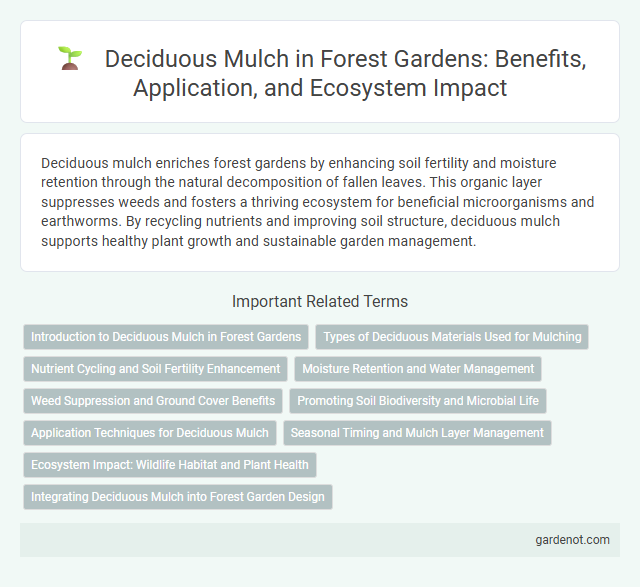Deciduous mulch enriches forest gardens by enhancing soil fertility and moisture retention through the natural decomposition of fallen leaves. This organic layer suppresses weeds and fosters a thriving ecosystem for beneficial microorganisms and earthworms. By recycling nutrients and improving soil structure, deciduous mulch supports healthy plant growth and sustainable garden management.
Introduction to Deciduous Mulch in Forest Gardens
Deciduous mulch, sourced from fallen leaves and organic debris, plays a crucial role in forest gardens by enriching soil fertility and enhancing moisture retention. This natural layer suppresses weeds while fostering beneficial microbial activity essential for nutrient cycling. Integrating deciduous mulch supports ecosystem health and contributes to sustainable forest garden management.
Types of Deciduous Materials Used for Mulching
Deciduous mulch primarily consists of fallen leaves, shredded bark, and wood chips derived from deciduous trees such as oak, maple, and beech, which decompose to enrich soil fertility and structure. Leaf litter from species like birch and ash offers high nutrient content and moisture retention, promoting healthy root growth in forest gardens. Incorporation of twigs and small branches alongside leaves enhances aeration and microbial activity, fostering a balanced ecosystem within the mulched area.
Nutrient Cycling and Soil Fertility Enhancement
Deciduous mulch plays a crucial role in nutrient cycling by decomposing organic matter and releasing essential nutrients like nitrogen, phosphorus, and potassium back into the soil. This process enhances soil fertility, promoting microbial activity and improving soil structure for better water retention and root growth. Incorporating deciduous mulch in forest gardens supports sustainable ecosystem function and long-term soil health.
Moisture Retention and Water Management
Deciduous mulch from fallen leaves enhances moisture retention by creating a natural barrier that reduces soil evaporation and stabilizes temperature fluctuations. Its organic composition gradually decomposes, improving soil structure and increasing water infiltration, thereby optimizing water management in forest gardens. Consistent use of deciduous mulch supports plant health by maintaining balanced soil moisture levels throughout seasonal changes.
Weed Suppression and Ground Cover Benefits
Deciduous mulch effectively suppresses weeds by creating a dense layer that limits sunlight penetration, reducing weed seed germination and growth. This natural ground cover enriches the soil with organic matter as it decomposes, improving moisture retention and nutrient availability for forest garden plants. Its seasonal renewal aligns with the forest garden's ecological cycles, promoting a healthy, sustainable ground ecosystem.
Promoting Soil Biodiversity and Microbial Life
Deciduous mulch enhances forest garden soil by providing a rich source of organic matter that fosters diverse microbial communities essential for nutrient cycling and soil structure. The gradual decomposition of fallen leaves supplies vital nutrients and creates microhabitats for beneficial fungi, bacteria, and invertebrates, boosting soil biodiversity. This natural mulch layer also supports increased microbial activity, which improves plant health and resilience against diseases in the forest garden ecosystem.
Application Techniques for Deciduous Mulch
Applying deciduous mulch in a forest garden involves spreading a 2-4 inch layer of shredded leaves or finely chopped hardwood materials around the base of plants to conserve moisture and suppress weeds. It is crucial to maintain a gap of a few inches from plant stems to prevent rot and promote air circulation. Regular replenishment each season supports soil fertility by gradually decomposing and enriching the organic content of the forest garden floor.
Seasonal Timing and Mulch Layer Management
Deciduous mulch in forest gardens should be applied during autumn when fallen leaves naturally accumulate, providing optimal seasonal timing for nutrient cycling. Maintaining a mulch layer thickness of 5-10 centimeters facilitates moisture retention and temperature regulation, preventing soil erosion and suppressing weeds. Regular monitoring and replenishment of the mulch layer ensure consistent decomposition rates and sustained soil fertility throughout the growing season.
Ecosystem Impact: Wildlife Habitat and Plant Health
Deciduous mulch enriches forest garden ecosystems by providing essential habitat and food sources for diverse wildlife, including beneficial insects, amphibians, and small mammals. The nutrient-rich leaf litter enhances soil fertility and moisture retention, promoting robust plant health and growth. This natural mulch also supports microbial diversity, crucial for nutrient cycling and overall ecosystem resilience.
Integrating Deciduous Mulch into Forest Garden Design
Integrating deciduous mulch into forest garden design enhances soil fertility by providing a steady supply of organic matter and essential nutrients as the leaves decompose. This natural layer promotes moisture retention, suppresses weeds, and supports beneficial soil microorganisms critical for plant health. Selecting diverse tree species with nutrient-rich leaves maximizes the mulch's effectiveness in creating a sustainable, self-supporting ecosystem.
Deciduous mulch Infographic

 gardenot.com
gardenot.com